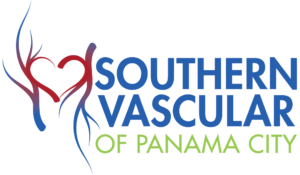Peripheral Artery Disease – Legs
Click to View Treatments
Peripheral Artery Disease – Legs
Peripheral artery disease is a condition of the blood vessels that leads to narrowing and hardening of the arteries that supply the legs and feet. The narrowing of the blood vessels leads to decreased blood flow, which can injure nerves and other tissues.
Causes
Peripheral artery disease is caused by arteriosclerosis, or “hardening of the arteries.” This problem occurs when fatty material (plaque) builds up on the walls of your arteries. This causes the arteries to become narrower. The walls of the arteries also become stiffer and cannot widen (dilate) to allow greater blood flow when needed.
As a result, when the muscles of your legs are working harder (such as during exercise or walking) they cannotget enough blood and oxygen. Eventually, there may not be enough blood and oxygen, even when the muscles are resting.Peripheral artery disease is a common disorder that usually affects men over age 50.
People are at higher risk ifthey have a history of:
- Abnormal cholesterol
- Diabetes
- Heart disease (coronary artery disease)
- High blood pressure (hypertension)
- Kidney disease involving hemodialysis
- Smoking
- Stroke (cerebrovascular disease)
Symptoms
The classic symptoms are pain, achiness, fatigue, burning, or discomfort in the muscles of your feet, calves, orthighs. These symptoms usually appear during walking or exercise and go away after several minutes of rest.
- At first, these symptoms may appear only when you walk uphill, walk faster, or walk for longer distances.
- Slowly, these symptoms come on more quickly and with less exercise.
- Your legs or feet may feel numb when you are at rest. The legs also may feel cool to the touch, and theskin may look pale.
When peripheral artery disease becomes severe, you may have:
- Impotence
- Pain and cramps at night
- Pain or tingling in the feet or toes, which can be so severe that even the weight of clothes or bed sheets is painful
- Pain that is worse when you raise the leg and improves when you dangle your legs over the side of the bed
- Skin that looks dark and blue
- Sores that do not heal
Prevention
You can help your circulatory system (heart and blood vessels). Heart disease risk factors that you have somecontrol over include high blood pressure, cholesterol levels, diabetes, obesity, and smoking.
- Eat a heart-healthy diet with reduced amounts of saturated fat and cholesterol, and control your weight. Follow your health care provider’s recommendations for treating high blood pressure, high cholesterol, ordiabetes. Reduce or stop smoking.
- Exercise may help prevent obesity, and it helps people with diabetes control their blood sugar.
- Exercise may help you maintain your abilities as much as possible and it reduces stress.
- Have regular check-ups for your heart: • Have your blood pressure checked every year. If you have diabetes, heart disease, kidney problems, or certain other conditions, your blood pressure may need to be monitored more closely. • If your cholesterol level is normal, have it rechecked every 5 years. If you have diabetes, heartdisease, kidney problems, or certain other conditions, your cholesterol may need to be monitored more closely.
- Moderate exercise is one of the best things you can do to keep your heart, and the rest of your body, healthy. Consult with your health care provider before beginning a new exercise program. Exercise moderately and within your capabilities, but do it regularly.
- People who exercise usually have less body fat and smoke less than people who do not exercise. They also tend to have fewer blood pressure problems and less heart disease.
Treatment
Quit smoking — this is the single most important change you can make to reduce your risk of heart disease andstroke.
Other lifestyle changes can also reduce your risk of hardening of the arteries:
- Avoid fatty foods. Eat well-balanced meals that are low in fat and cholesterol. Include several daily servingsof fruits and vegetables. Adding fish to your diet at least twice a week may be helpful. However, do not eat fried fish.
- Limit how much alcohol you drink — one drink a day for women, two a day for men.
- Exercise for 30 minutes a day if you are not overweight, and for 60 – 90 minutes a day if you are overweight. Talk to your doctor before starting a new exercise plan, especially if you have been diagnosed with heart disease or you have ever had a heart attack.
Get your blood pressure checked every 1 – 2 years before age 50 and yearly after age 50. Have your blood pressure checked more often if you have high blood pressure, heart disease, or you have had a stroke. Talk to your doctor about how often you should have your blood pressure checked.
If your blood pressure is high, it is important for you to lower it and keep it under control.
- Everyone should keep their blood pressure below 140/90 mmHg
- If you have diabetes, kidney disease, or have had a stroke or heart attack, your blood pressure shouldprobably be lower. Ask your doctor what your blood pressure should be.
Your doctor may want you to take medicine for high cholesterol levels if lifestyle changes do not work. This will depend on:
- Your age
- Whether you have heart disease or other blood flow problems
- Whether you smoke or are overweight
- Whether you have high blood pressure or diabetes
Your doctor may suggest taking aspirin or another medicine to help prevent blood clots from forming in your arteries. These medicines are called antiplatelet drugs. DO NOT take aspirin without first talking to your doctor.
